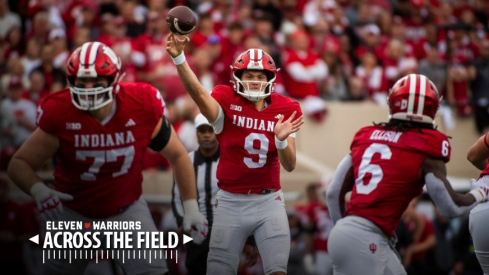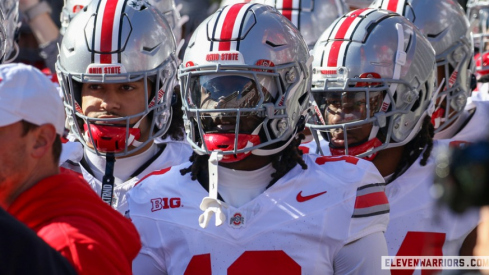Way out on the Western edge of Ohio, in Mercer County, lies the village of St. Henry, OH. Having a population of only 2271 (as of 2000), it is not among the largest or most well-known cities in Ohio. And yet, St. Henry High School has won 6 state championships in football since 1990. In fact, the school is tied with Versailles High School (also in Western Ohio) for the most state championships in Ohio by a public school since the introduction of the modern playoff system in 1972. Apparently, those small town boys can play some ball.
If the town sounds familiar to your OSU-loving ears, it's probably because it is the hometown of the Buckeyes' former starting quarterback Todd Boeckman. Perhaps if you are a little bit older, you might recall that St. Henry is also the hometown of OSU's 2nd all-time leading passer, Bobby Hoying (and also his high school teammate, former Penn State and Pittsburgh Steelers lineman Jeff Hartings). But I'll always remember St. Henry for producing one of the best offensive linemen ever to play for Ohio State, Jim Lachey.
 The quickest first step you'll ever see for a lineman.
The quickest first step you'll ever see for a lineman.(Photo courtesy of www.BestSportsPhotos.com)
Jim Lachey was a multi-sport athlete at St. Henry high, running the 100 and 200 meter races and doing shot put for the track team. He also was a starter on their state championship basketball team. But it was in football where he would make the biggest noise, and it was enough to catch the eye of Earle Bruce and the OSU coaching staff. Lachey was rather light for a 6'6" offensive lineman (around 245 pounds), but the coaches felt that his frame could hold a lot more weight, and that a couple of years in the weight room and at the training table would yield great results. But what really impressed them was his quickness off the snap. He had such an explosive first step that most defensive linemen couldn't get into good position before he had the advantage on them.
Lachey's first two years in the program were long on potential but short on playing time. Sitting behind 4-year starter Joe Lukens did not afford many opportunities for the young guard. But when Lukens graduated, he made the most of it and earned significant playing time at left guard for the 1983 season (he shared the position with Kirk Lowdermilk). Game one against Oregon was a little rough, as the new running backs (replacing graduated 2-year starter Tim Spencer) had trouble finding any room to run. Starter Kelvin Lindsey could not find cut-back lanes, and 2nd teamer (at the time) Keith Byars was stuffed for less than 5 yards on 4 carries, including a fumble. Fortunately, QB Mike Tomczak hooked up with receivers Cedric Anderson and Thad Jemison at will and the passing game carried the team to an easy victory. But anyone who knew coach Earle Bruce knew that he would not be satisfied until the running game came around. And it needed to come around quickly in order to survive their next game.
In week 2, OSU traveled to Oklahoma to face Barry Switzer's Sooners. The passing game clicked well between Tomczak and TE John Frank, but this time the running game also contributed as Byars rushed for 57 yards. The team made the most of a couple Sooner turnovers and walked away with a 24-14 victory. From there the running game (and the offense in general) mostly rolled, with the exception of road losses to Iowa and Illinois. In the season finale at Michigan, the team was trailing 17-14 but was driving in Michigan territory. Lachey and the line were blocking well and Byars was steadily chewing up the yards. But then coach Bruce reached a little too far into his bag of tricks and produced one of the most infamous plays in OSU history.
For several years, Nebraska had been running a trick play that became known as the "Fumblerooski". The idea is for the QB to intentionally fumble the ball at the snap, and do it in such a way that one of the linemen can pick the ball up and run for big yardage, perhaps a touchdown. The Cornhuskers would famously execute the play to perfection in their Orange Bowl loss to Miami later that season, with guard Dean Steinkuhler running the ball in for a TD. Coach Bruce added the play to Ohio State's arsenal, and the team practiced it all season waiting for just the right moment to let it go. In the 4th quarter of the season finale, trailing by 4 but driving deep in enemy territory, it seemed like a perfect place for a trick play. But it was not to be.
The plan was for Mike Tomczak to drop the snap and run the play to the left, while Lachey picked up the ball and ran right. Lachey had 4.6 speed, unusual for a lineman, and so if the deception was pulled off right the play would almost certainly result in a touchdown. Unfortunately, the fumbled football did not stay where it was dropped, and by the time Lachey went to look for it the ball was 7 yards downfield. Michigan's noseguard recovered and they seized the momentum and went on a game-clinching touchdown drive. As a result, the play (which was dubbed "Lachey Right") became just one more piece of ammunition for Bruce's many critics.
In 1984, Lachey became a full-time starter at LG as Lowdermilk was moved to center. He was a well-established mainstay on a veteran offensive line that would be the anchor for the team. After the shaky start against Oregon State, the offense rolled along behind the experienced leaders on the line. Byars rushed for 1764 yards and 22 TDs, and amassed a school-record 2441 all-purpose yards. Byars and Lachey were both named first team All-Americans, and Byars finished 2nd in the Heisman Trophy voting. Lachey played his entire career at guard for Ohio State, but in the NFL his future would be on the outside. He was invited to play in the East-West Shrine game, an annual showcase of senior players for NFL scouts. He practiced all week at guard, but on the morning of the game one of the coaches informed him that he would be playing left tackle in the game. Apparently, the scouts all wanted to see how he would perform there. He must have impressed them because the San Diego Chargers chose Lachey in the first round of the draft, making him the 12th player taken overall.
 Lawrence Taylor, you've met your match!
Lawrence Taylor, you've met your match!(Photo courtesy of www.TheHogs.net)
Having moved permanently to left tackle, Lachey played 3 seasons with the Chargers, making his first Pro Bowl in 1987. After that he was traded twice in a span of 5 weeks, going first to the Raiders and then to the Redskins. With Washington he made 2 more Pro Bowls and helped the Redskins win the Super Bowl in 1991. He played 3 more seasons (missing an entire season in 1993 due to injury) and then retired in 1995. To this day, he is regarded as one of the best offensive linemen ever to play for the team, which is significant when you consider how fondly the Redskins' fans regard their "Hogs". In 2002, as part of the 70th anniversary of the team, Lachey was named one of the 70 Greatest Redskins. After retirement, Lachey moved back to Columbus and took over as radio color analyst in the booth for all OSU football games. In 2001, as part of the All Pro Football video series, he was featured in an instructional video called Jim Lachey: The Ultimate Protector. A cheesy title, to be sure. But considering the importance of a left tackle in the NFL, it seems appropriate. I think the people back in St. Henry would be proud.

